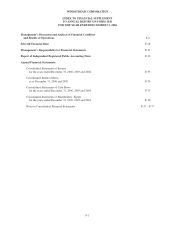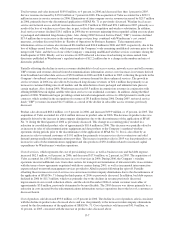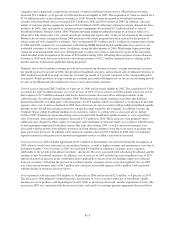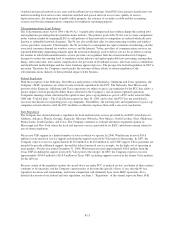Windstream 2006 Annual Report Download - page 106
Download and view the complete annual report
Please find page 106 of the 2006 Windstream annual report below. You can navigate through the pages in the report by either clicking on the pages listed below, or by using the keyword search tool below to find specific information within the annual report.
Pages on advertising revenues generated from its directories for the duration of the Publishing Agreement. In
conjunction with the Publishing Agreement, the Company has entered into an at-market executory contract to purchase
minimum advertising in its directories for a period of three years, with a renewal option for two additional years
available to WCAS.
Discontinuance of the Application of SFAS No. 71 “Accounting for the Effects of Certain Types of Regulation”
Historically, the Company’s Incumbent Local Exchange Carrier (“ILEC”) operations, except for certain operations
acquired in Kentucky in 2002 and in Nebraska in 1999, followed the accounting for regulated enterprises prescribed by
SFAS No. 71. This accounting recognizes the economic effects of rate regulation by recording costs and a return on
investment as such amounts are recovered through rates authorized by regulatory authorities. Recent changes, however,
have impacted the dynamics of Windstream’s business environment. Specifically, on July 12, 2006, the Company
transitioned its Kentucky intrastate operations, which were historically subject to rate-of-return regulation, to a newly
established alternative form of regulation. In addition, on July 17, 2006, Windstream announced its completion of the
spin-off of Alltel Corporation’s wireline business and merger with Valor, as discussed above. The former Valor
properties are primarily subject to alternative price cap regulation. Accordingly, we have considered the change in the
mix of our customer and revenue base from rate-of-return to an alternative form of regulation resulting from increased
competition in our current assessment of criteria for the continued application of SFAS No. 71.
Additionally, we are experiencing access line losses due to increasing levels of competition across all Windstream
service areas. This competition is driven largely by the technological development of alternative voice providers
including wireless, cable, Voice over Internet Protocol (“VoIP”), and Competitive Local Exchange Carriers. These
alternative voice products have transformed a pricing structure historically based on the recovery of costs to a pricing
structure based on market conditions, including the bundling of services and discounts.
Based on these material factors impacting its operations, Windstream determined in the third quarter 2006, that it is no
longer appropriate to continue the application of SFAS No. 71 for reporting its financial results. Accordingly,
Windstream recorded a non-cash extraordinary gain of $99.7 million, net of taxes of $74.5 million, upon
discontinuance of the provisions of SFAS No. 71, as required by the provisions of SFAS No. 101, “Regulated
Enterprises – Accounting for the Discontinuation of the Application of FASB Statement No. 71.” In addition, during
the third quarter of 2006, Windstream began eliminating all intercompany revenues and related expenses. Previously,
certain intercompany revenues and expenses earned and incurred by the Company’s regulated subsidiaries were not
eliminated because they were priced in accordance with Federal Communication Commission guidelines and were
recovered through the regulatory process.
Adoption of Accounting Standards
As of December 31, 2006, the Company adopted the provisions of SFAS No. 158 “Employers’ Accounting for Defined
Benefit Pension and Other Postretirement Plans, an amendment of FASB Statements No. 87, 88, 106 and 132 (R)”. The
guidance of SFAS No. 158 requires us to recognize on our consolidated balance sheet the over-funded or under-funded
amount of our defined benefit postretirement plans. This amount is defined as the difference between the fair value of
plan assets and the benefit obligation. We are also required to recognize as a component of accumulated other
comprehensive income, net of taxes, the actuarial gains and losses and the prior service costs and credits have arisen
but were not previously required to be recognized as components of net periodic benefit cost. Accumulated other
comprehensive income is then adjusted as these amounts are later recognized into income as components of net
periodic benefit cost. The adoption of SFAS No. 158 resulted in a reduction of our prepaid pension assets of $103.2
million, an increase in our liability for pension and other postretirement benefits of $106.1 million, a reduction in
deferred taxes of $82.1 million and a reduction of accumulated other comprehensive income of $127.2 million. See
Note 8, “Employee Benefit Plans and Postretirement Benefits”, for further details on the amounts reflected in our
consolidated balance sheets.
On January 1, 2006, the Company adopted SFAS No. 123(R), “Share-Based Payment”, which is a revision of SFAS
No. 123 and supercedes APB Opinion No. 25. SFAS No. 123(R) requires all share-based payments to employees,
including grants of employee stock options, to be valued at fair value on the date of grant, and to be expensed over the
applicable vesting period. In addition, companies must also recognize compensation expense related to any awards that
are not fully vested as of the effective date. Compensation expense for the unvested awards is measured based on the fair
value of the awards previously calculated in developing the pro forma disclosures in accordance with the provisions of
SFAS No. 123. Upon adoption of the standard, the Company followed the modified prospective transition method and
F-5
























